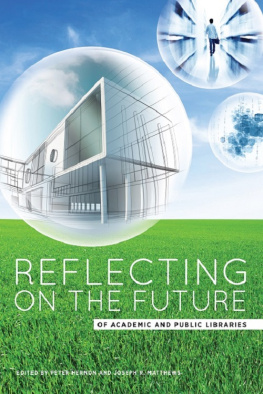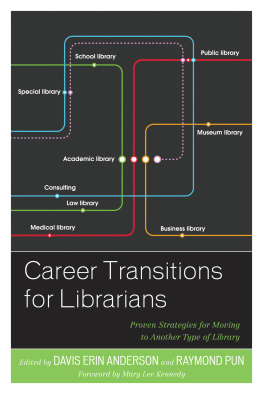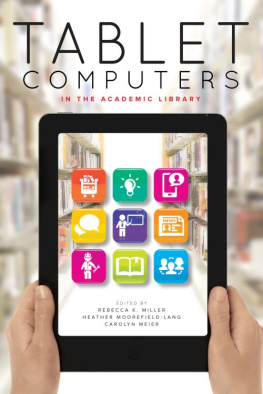
ALA Editions purchases fund advocacy, awareness, and accreditation programs for library professionals worldwide.

2013 by the American Library Association. Any claim of copyright is subject to applicable limitations and exceptions, such as rights of fair use and library copying pursuant to Sections 107 and 108 of the U.S. Copyright Act. No copyright is claimed for content in the public domain, such as works of the U.S. government.
Extensive effort has gone into ensuring the reliability of the information in this book; however, the publisher makes no warranty, express or implied, with respect to the material contained herein.
ISBNs: 978-0-8389-1187-7 (paper); 978-0-8389-9601-0 (PDF); 978-0-8389-9602-7 (ePub); 978-0-8389-9603-4 (Kindle). For more information on digital formats, visit the ALA Store at alastore.ala.org and select eEditions.
Library of Congress Cataloging-in-Publication Data
Reflecting on the future of academic and public libraries / edited by Peter Hernon and Joseph R. Matthews.
pages cm
Includes bibliographical references and .
ISBN 978-0-8389-1187-7
1. Academic librariesForecasting. 2. Public librariesForecasting. 3. Library planning. 4. Organizational change. I. Hernon, Peter. II. Matthews, Joseph R.
Z675.U5R4435 2013
027.473'0112dc23 2012036382
Cover design by Kimberly Thornton.
Contents
/ by Richard Fyffe
/ by Diane J. Graves
/ by Danuta A. Nitecki
/ by Robert E. Dugan
/ by Neel Parikh
/ by Pam Sandlian-Smith
Figures
Tables
Boxes
Many libraries face serious problems stemming from the economic recession of 20082009 and its aftermath, as well as from the ever-changing information-seeking behavior of their customers and the presence of information technologies that affect such behavior. In some instances, fiscal problems predate the recession. At the same time, there is an increased expectation that libraries demonstrate accountability, collaborate more with stakeholders and other libraries, and, in some instances, generate alternative sources of revenue. How should libraries respond to such pressures? Is it enough to continue to do the same things or, at most, introduce incremental change? On the contrary, we believe that the times call for dramatic transformational change and the creation of a vision of the future that excites library staff and stakeholders.
The mention of change management and the future of public, academic, or any other type of library suggests someone staring into a crystal ball and trying to predict the future. The emerging vision, as commonly portrayed in the literature on scenario development, might assume hypothetical facts and extend the projection for thirty to fifty years, but without producing anything relevant to help libraries anticipate, prepare for, and manage change. This book does not offer predictions; rather, it offers portrayals of the future through shorter-range scenarios, stories projected a maximum of fifteen years ahead. These scenarios contain elements or threads grounded in the present that libraries or other organizations can use as they piece together a story that is relevant to local circumstances and can be linked to strategic planning and change management. The goal is to help libraries produce a story that they can use to explore surprises and discontinuities in the planning process and to obtain staff and stakeholder buy-in to a vision that enables everyone to concentrate on the bigger picture.
The scenarios presented in suggests that scenarios also apply to the broader organization, and such scenarios merit review as library managerial leaders settle on the preferred future. The goals of this book are to identify relevant literature and possible scenarios and to get readers to think about the future and what the library infrastructure (staff, collections, technology, and facilities) will resemble.
We acknowledge that some useful scenarios have been offered for academic libraries, but our scenarios contain many elements not found in them. There is, moreover, a dearth of good scenarios for public libraries. Unlike other works, this one offers scenarios for both academic and public libraries at a time when many library managers may be consumed by the present and how to cope with scarce or reduced resources. We believe that the present serves as an opportunity to create a new and positive future, as some libraries are doing. After all, are there not dangers in thinking solely in terms of the present?
Reflecting on the Future of Academic and Public Libraries separates scenarios from scenario planning, and we believe that librarians can take any of the scenarios and apply scenario planning to explore a preferred future in more detail, factoring in local circumstances. We view scenarios as a tool for managerial leaders to use to generate discussion within the organization and with stakeholders as they prepare for a transformation that requires forming new partnerships, collaborating, staking out new service roles, and ensuring the workforce has the required Her comments could apply to public libraries and to the achievement of any transformational vision that requires relationship building to get others to accept, shape, and help to carry it out.
ALA Editions wanted a book that would alert those who are preparing to enter the professional workforce of academic and public libraries about how libraries are changing, what they might look like, and the types of skills they will need to prosper in the new setting. Through our many years of teaching in schools of library and information science, we have found that many of our students have impressions of library work that do not match reality or take into account the forces of dramatic change. Library directors may be flattening the organizational structure, merging and eliminating departments, starting new services, and participating more broadly within their communities. We cite key literature to reflect the changed environment, and the scenarios presented in have been reviewed by several influential library directors. Still, we recognize that no set of scenarios can be comprehensive; rather, they are suggestive.
We also see the audience of this book as comprising managerial leaders and staff of academic and public libraries as they move beyond the issues of the moment to piece together their vision of the library of the future. This audience extends to include the stakeholders with whom library managerial leaders deal, such as members of governing boards. None of these actors can afford to succumb to the idea that there is no longer any need for a library or that all resources are available on the Internet. Instead, they need to invest more extensively in advocacy as they stake out a future that can be realistically achievedone that will take time to achieveand as they convert library spaces to new service roles.
Reflecting on the Future of Academic and Public Libraries, our second collaboration, represents our many years of thinking about libraries and .
Note
.
The purpose of the work on making the future is not to decide what should be done tomorrow, but what should be done today to have a tomorrow.
Peter Drucker
T he historically has been developmental or, in some instances, transitional; however, with the economic recession that began in 2008 and its aftermath, there seem to be more instances of transformational change.















